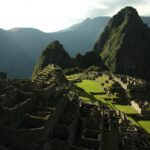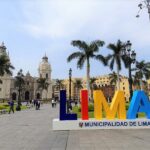Are you looking for the best Peru travel itineraries for your upcoming trip? As a Peruvian who has traveled all around Peru, in this post I will recommend you what I consider the top routes around the country’s highlights.
From the mystical Andes towns and sites, such as Cusco and Machu Picchu, to the sand dunes of Huacachina in the coast, and the vibrant Amazon rainforest, Peru has it all.
In this post we will take a look at what are some of the best itineraries around Peru, whether you land in Lima or are traveling overland from Ecuador, Chile or Bolivia.
I am proposing here several travel itineraries: 1 week in Peru, two different 10-day itineraries, a 3 week itinerary and a longer backpacking route. For that last one, the amount of time you will stay at each destination depends on the total amount of time you have.
1 Week Peru Itinerary: Lima and Cusco
- Day 1: Lima
- Days 2-3: Cusco city
- Day 4: Ollantaytambo, Aguas Calientes
- Day 5: Machu Picchu, Cusco city
- Day 6: Cusco city, Maras and Moray or Rainbow Mountain
- Day 7: Lima
You can read the itinerary overview below. For Days 2-6 you can find a detailed itinerary here: 5 days in Cusco.



Overview of this 1-Week Itinerary
The first of this Peru travel itineraries is the standard itinerary that most travelers who come to Peru for a week follow.
First, you land in Lima, where I recommend you stay for one day. In Lima, you can visit the historic center, walk around the boardwalk in Miraflores en Barranco, and enjoy Peruvian food at a good restaurant. If you didn’t know, some of the best restaurants in the world are in Lima!
Next, take a flight to Cusco city. Cusco city is the capital of the Cusco region, and it’s a very beautiful old city, a mix of nativa Inca heritage and Spanish colonial influence.
In total, spend 5 days in Cusco. . The first two days enjoy Cusco city, its cobblestone streets, Inca fortresses and traditional markets.
On Day 4, head from Cusco to the Sacred Valley and spend a day at Ollantaytambo, a cute old town with archaological sites amidst the Andes mountains.
On the evening of Day 4, take the train to Aguas Calientes, and sleep there. The early morning of Day 5, hike or take the bus to Machu Picchu. This will be the highlight of your trip! In the late afternoon or evening, head back to Cusco city via Ollantaytambo.
Day 6 is up to you. You can keep exploring Cusco city or take a a half day tour to the Maras pink salt mines and Moray ruins.
You can either fly back to Lima on the evening of Day 6 or early morning of Day 7. If you decide to fly back to Lima on Day 7, on Day 6 you could even visit the Rainbow Mountain. That is, if you have the energy, since it implies starting your day at 4am.
Spend day 7 doing some shopping in Lima and buying some nice Peruvian presents to take back home.
10-day Peru Itinerary (option 1): Lima, Cusco and Amazon Rainforest
- Day 1: Lima
- Day 2: Cusco city
- Day 3: Cusco city, Maras and Moray
- Day 4: Pisac and Ollantaytambo.
- Day 5: Machu Picchu
- Day 6: Manu National Park
- Day 7: Manu National Park
- Day 8: Manu National Park
- Day 9: Manu National Park
- Day 10: Lima. Fly back home.
You can read the itinerary overview below, or the detailed itinerary here: 10 Days in Peru




I have made two different Peru travel itineraries if you have 10 days to visit. The first one is this one, where on the first part you get to visit Lima, spend time in Cusco, the Sacred Valley and Machu Picchu. It’s much like the 1 week itinerary.
One difference is that I have added a stop at Pisac, in the Sacred Valley, before heading to Ollantaytambo. Pisac is famous for its ruins and its market, and it makes for a great morning trip.
On top of that, on this itinerary you will spend some days at the Manu National Park, in the Amazon rainforest. The Manu National Park is actually one of the most bio diverse places in the planet, so if you like nature you shouldn’t miss it!
There are several tour companies that will take you from Cusco to the Manu National Park. The tours involve sleeping in lodges in the jungle, doing walks in nature, spotting wildlife and exploring the jungle by boat. Then they take you back to Cusco, from where can catch a flight back to Lima.
You can get all the details in this post about a ten-day itinerary to Peru.
10-day Peru Itinerary (option 2): Lima, Arequipa and Cusco
- Day 1: Lima
- Day 2: Arequipa city
- Day 3: Arequipa city
- Day 4: Colca Valley
- Day 5: Colca Valley, Arequipa, Cusco city
- Day 6: Cusco city
- Day 7: Ollantaytambo.
- Day 8: Machu Picchu
- Day 9: Cusco. Optional: Maras and Moray.
- Day 10: Lima.




When writing this post about Peru travel itineraries, I decided to make a second 10-day option for those who think they might not enjoy the jungle. Instead of the rainforest, in this itinerary you will visit Arequipa, a region in the Peruvian Andes.
Arequipa city is the capital of the Arequipa province. It’s an old colonial city where you can spend two relaxing days (Days 2 and 3). Visit places like the Santa Catalina Monastery, exploring its squares and trying some local food. You can check out here more things to do in Arequipa.
On Day 4, head to the Colca Valley. To get there, you can either take a bus or book a 2-day tour. The way there has beautiful landscapes, with vicuñas and alpacas roaming around.
Spend the rest of Day 4 in one of the small towns in the valley, like Chivay or Yanque. Enjoy the views of the mountains and visiting some hot springs.
On Day 5, visit La Cruz del Condor, a view point from where you will get to spot Condors overflying the Colca Canyon which is is the 2nd deepest canyon in the world. Get back to Arequipa and fly to Cusco city in the afternoon.
The rest of the itinerary is much like this itinerary of 5 days in Cusco.
3 Weeks in Peru
- Days 1-2: Lima
- Day 3-4: Arequipa city
- Day 5: Colca Valley
- Days 6: Colca Valley, Arequipa city
- Day 7-8: Cusco city
- Day 9: Cusco with day trip to Maras, Moray and Chinchero
- Day 10: Pisac
- Day 11: Ollantaytambo, Aguas Calientes
- Day 12: Machu Picchu
- Day 13: Cusco city. Optional: hiking or Rainbow Mountain
- Days 14-17: Manu National Park
- Day 18: Cusco to Puno, with stops along the way
- Day 19: Lake Titicaca and islands (Uros and Amantani islands)
- Day 20: Taquile island and back to Lima
- Day 21: Lima
You can read the itinerary overview below, or find the detailed itinerary here: 3 Weeks in Peru.








Quick Overview of this 3-Week Itinerary
This travel itinerary is a combination of the two previous ten-day itineraries in Peru.
In your three weeks, you will start by visiting Lima, then head to Arequipa and the Colca Valley. From there, you will continue to Cusco, the Sacred Valley and Machu Picchu. Afterwards, you spend some days at the Amazon rainforest, get back to Cusco, and from there head to Puno and Lake Titicaca.
You can find all the details of that itinerary in this post about spending 3 weeks traveling around Peru.
If you are not a fan of the jungle, though, you could skip the Manu National Park. One option could be to get Cusco to Puno directly. Fly back to Lima earlier. From Lima, you can fly to Máncora, and spend 3 relaxing days at the beach.
Otherwise, you could use two of those nights before heading to Arequipa. After Days 1-2 in Lima, you could visit Paracas and the Ballestas Islands on Day 3 and exploring Huacachina on Day 4. From there you could either take a bus night to Arequipa, or get back to Lim and fly from there. The last extra day you could use it to visit the Rainbow Mountain in Cusco.
Peru Backpacking Travel Itinerary (North to South or Viceversa)
- Máncora
- Chachapoyas
- Cajamarca
- Huanchaco
- Huaraz
- Lima
- Paracas
- Huacachina
- Ayacucho
- Cusco (Sacred Valley, Machu Picchu)
- Manu National Park – Cusco
- Puno
- Arequipa
- Colca Valley – Arequipa
- Cross to Chile or back to Puno if entering Bolivia
You can read the itinerary overview below. For your time in Lima, you can take a look at our Lima itineraries. And for your time in Cusco, this 5-day itinerary in Cusco can be a good guide.











In contrast to the previous Peru travel itineraries, this one is specifically tailored for backpackers. It’s a route along some of Peru’s highlights, as well as some off-the-beaten-path destinations in Peru.
This itinerary implies that you are entering Peru from Ecuador.
If you are entering from Bolivia or Chile instead, do the same route but backwards.
Quick Overview of This Peru Backpacking Travel Itinerary:
From the border, take a bus to Mancora, a nice and relaxing beach town and a great surfing destination.
Continue to Chachapoyas, in the high jungle of Peru. Take a cable car to Kuelap Fortress and hike to one of the tallest waterfalls in the world.
Head to Cajamarca, an off-the-beaten-path colonial city in the Andes in the middle of nature.
Return to the coast and visit Huanchaco, a small fishermen village near Trujillo.
Continue South to Huaraz, the hiking capital of Peru. Visit turquoise lakes surrounded by snow-capped mountains.
After that, visit Lima, the capital of Peru. Spend some days here with the conveniences of being back in a big city. Visit the historic center, modern Miraflores and artsy Barranco.
Go further South and enjoy the activities you can do in Paracas, like visiting the Ballestas Islands and the Candelabra. From there, visit Huacachina, a small oasis and enjoy sandboarding, dune buggy rides, and visit a pisco (a Peruvian drink) factory. You could do a day trip from there to overfly the Nazca lines.
Head West to Ayacucho, a small city in the Andes from which you can visit the Vilcashuaman ruins and the Millpu turquoise waters.
Continue your journey West towards Cusco, and enjoy Cusco city, the Sacred Valley, and Machu Picchu. If you have a lot of time, you can easily spend two weeks exploring Cusco, and even more if you plan to hike the Inca trail.
Afterwards, explore the jungle at the Manu National Park. Return to Cusco and take a bus to Puno. Enjoy the many things to do in Puno, like visiting the islands at Lake Titicaca.
Head to the colonial Arequipa city and spend some time at the Colca Valley and Colca Canyon.
Continuing Your Trip To Other Countries
At the end of your trip, depending on what your next destination is, from Arequipa either head back to Lima, continue towards Tacna to cross to Chile, or go back to Puno if you want to cross to Bolivia.
Custom Peru Travel Itineraries
Do you need help with a custom itinerary? I am Peruvian and have traveled all around Peru, to the places I write about and many others.
I can help you organize your trip according to your interests, time and budget. According to these, I can plan the best Peru travel itinerary for you, including recommendations of what to do at every place, help you with buses or train information, booking restaurants, hotel suggestions, etc. I live in Lima so I can also book for you a trustworthy English-speaking taxi driver from Lima airport.
The rate is 45 dollars per day of the personalized travel itinerary. If you are interested, write me an email at sharon@itravelperu.com.
FAQ About Planning a Peru Itinerary
Here are some questions that might come up when you are planning your trip to Peru.
For how long can I stay in Peru?
Foreigners are allows to stay up to 180 days over a period of 365 days. However, most tourists get a standard 90 day entry permit (or less). If you are planning to stay longer, talk to the customs agent before they register your passport information into their system. You are not guaranteed to get 180 days at once, but it’s possible you could.
How much should I budget for my travel itinerary in Peru?
It really depends on the city or town you are visiting.
In Lima, you can spend a lot if you want, by staying at high-end hotels and eating at fancy restaurants. A night at a 5-star hotel in Lima or Cusco will cost around USD$ 300 or USD$ 400 upwards, but a room at a dorm can cost USD$ 10-20. And meal at a nice restaurant can cost you USD$ 20 or more per person in Lima, and maybe USD10-15 in Cusco. But there are also high-end restaurants in Lima, like Maido or Central, which are around USD$350 per person.
In small towns you budget much less per day. In a town in the Sacred Valley for example, , you could have a meal for USD$4-7.
Do I need to bring cash or is it easy to pay by credit card?
In the cities you will have no problem paying by card at hotels, restaurants and shops. But if you are visiting small towns, markets, taking public transport, etc, you will need to have cash with you. Cash will also be handy for when you leave a tip in Peru, for example at restaurants or to your porters if you hike the Inca Trail.
What’s the best season to travel to Peru?
The best season is the shoulder season, April-May and October. These months are part of the dry season in Peru, so that you can enjoy a nicer weather if you are planning to hike or visit Machu Picchu. June to September are just in the middle of the dry season but there will be more crowds at Machu Picchu and the weather on the coast will be cold.
What kind of clothes do I need to bring to Peru?
If you visit Peru during the rainy season (November/December to March), bring summer clothes for Lima but a poncho for the Cusco and areas in the Andes. And if you travel during the dry season in Peru (April to November), bring winter clothes for the coast.
If you are traveling to Cusco, Arequipa, or other regions in the Andes, bring warm clothes regardless of the season, especially for the night. Days can be sunny and warm, and a T-shirt might be fine. But the nights are cold and usually you need a sweater and a jacket.
For more information about what kind of clothes to bring for Lima according to the season, you can read this post about what to wear in Lima.






